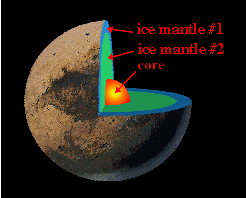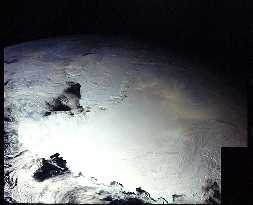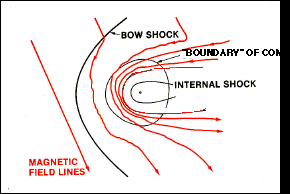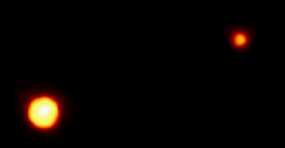This is an image of the surface of Pluto.
Image from: NASA
Pluto's Surface and Interior
Data from 1999 suggests that the surface of Pluto is made of several components; it has both an icy component and another component which may be rocky. The icy component is primarily made of frozen nitrogen, but likely contains smaller amounts of frozen carbon monoxide and methane. Pluto is so far away that is it very hard to see the planet, so we can't yet tell how much of the surface is covered with ice, and how much is covered with something which is not ice (the possibly rocky component). But the surface is good at reflecting light, which suggests that it is mostly made of the icy component - and that means Pluto's surface is mostly composed of nitrogen.
The surface of Pluto shows remarkable dark markings reminiscent of Saturn's moon Iapetus. Winds of Pluto's atmosphere may contribute to sweeping the ices away from some regions and leaving dark markings, as can be seen in this image.
The interior of Pluto is probably similar to that of major icy moons such as Ganymede. (Pluto is smaller than Ganymede).
The evolution of the binary planet Pluto and Charon may be like only one other planet in the solar system, that of the Earth and its moon.
You might also be interested in:

It may seem hard to believe that Pluto could have an atmosphere because it is so cold at 39 AU, where Pluto resides, but it does. Because there are times when Pluto is closer to the sun than is Neptune
...more
The diagram to the left shows a cutaway of the possible interior structure of Pluto. The composition of Pluto is mostly ice, therefore there is probably a small core of some rocky material buried inside,
...more
Of all the planets and moons in the solar system, Pluto and Charon are the two which resemble each other the most closely. They are almost the same size, and they are very close together. They are so
...more
Pluto is a frigid ball of ice and rock that orbits far from the Sun on the frozen fringes of our Solar System. Considered a planet, though a rather odd one, from its discovery in 1930 until 2006, it was
...more
Pluto is so far away, and has never been explored. Questions to answer about Pluto include the following: What are the geologic features of the surface. (pictures of the surface) If there are bare spots,
...more
No one knows whether or not Pluto has a magnetosphere. Scientists were very surprised to find that Jupiter's icy moon Ganymede had a magnetosphere because it is hard to explain how an icy body can develop
...more
Pluto has // Call the moon count function defined in the document head print_moon_count('pluto'); known moons. Charon, the largest by far, was discovered in 1978 by the American astronomer James Christy.
...more














